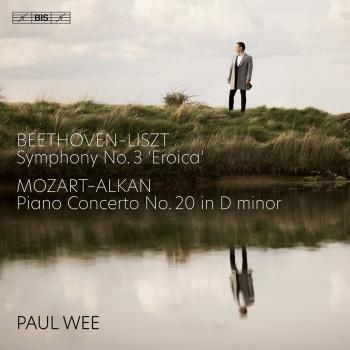
Thalberg: L'art du chant appliqué au piano, Op. 70 Paul Wee
Album Info
Album Veröffentlichung:
2020
HRA-Veröffentlichung:
06.11.2020
Label: BIS
Genre: Classical
Subgenre: Instrumental
Interpret: Paul Wee
Komponist: Sigismond Fortune Francois Thalberg (1812-1871)
Das Album enthält Albumcover Booklet (PDF)
- Sigismond Thalberg (1812 - 1871): L'art du chant appliqué au piano, Op. 70, Series 1:
- 1L'art du chant appliqué au piano, Op. 70, Series 1: No. 1, A te, o cara (After Bellini's "I puritani")05:10
- 2L'art du chant appliqué au piano, Op. 70, Series 1: No. 2, Tre giorni (After Ciampi) [Attrib. Pergolesi's P. 106]05:23
- 3L'art du chant appliqué au piano, Op. 70, Series 1: No. 3, Adelaide (After Beethoven's Op. 46)06:26
- 4L'art du chant appliqué au piano, Op. 70, Series 1: No. 4, Pietà, signore (Attrib. Stradella)09:07
- 5L'art du chant appliqué au piano, Op. 70, Series 1: No. 5a, Lacrimosa (After Mozart's K. 626)03:44
- 6L'art du chant appliqué au piano, Op. 70, Series 1: No. 5b, Sull'aria (After Mozart's K. 492)03:16
- 7L'art du chant appliqué au piano, Op. 70, Series 1: No. 6, Perchè mi guardi e piangi (After Rossini's "Zelmira")05:50
- L'art du chant appliqué au piano, Op. 70, Series 2:
- 8L'art du chant appliqué au piano, Op. 70, Series 2: No. 7, Bella adorate incognita (After Mercadante's "Il giuramento")05:51
- 9L'art du chant appliqué au piano, Op. 70, Series 2: No. 8, Nel silenzio fra l'orror (After Meyerbeer's "Il crociato in Egitto")04:55
- 10L'art du chant appliqué au piano, Op. 70, Series 2: No. 9, Einsam bin ich nicht alleine (After Weber's J. 279)03:12
- 11L'art du chant appliqué au piano, Op. 70, Series 2: No. 10, Der Müller und der Bach (After Schubert's D. 795)04:29
- 12L'art du chant appliqué au piano, Op. 70, Series 2: No. 11, Schelm, halt fest! (After Weber's J. 277)03:55
- 13L'art du chant appliqué au piano, Op. 70, Series 2: No. 12, Il mio tesoro (After Mozart's K. 527)04:50
- L'art du chant appliqué au piano, Op. 70, Series 3:
- 14L'art du chant appliqué au piano, Op. 70, Series 3: No. 13, Sérénade (After Rossini's "Il barbiere di Siviglia")03:45
- 15L'art du chant appliqué au piano, Op. 70, Series 3: No. 14, La dove prende (After Mozart's K. 620)03:56
- 16L'art du chant appliqué au piano, Op. 70, Series 3: No. 15, Barcarolle (After Donizetti's "Gianni di Calais")06:50
- 17L'art du chant appliqué au piano, Op. 70, Series 3: No. 16a, Protegga il giusto cielo (After Mozart's K. 527)03:38
- 18L'art du chant appliqué au piano, Op. 70, Series 3: No. 16b, Là ci darem la mano (After Mozart's K. 527)03:31
- 19L'art du chant appliqué au piano, Op. 70, Series 3: No. 17, Sérénade (After Grétry's "L'amant jaloux")03:18
- 20L'art du chant appliqué au piano, Op. 70, Series 3: No. 18, Assisa a piè d'un salice (After Rossini's "Otello")05:08
- L'art du chant appliqué au piano, Op. 70, Series 4:
- 21L'art du chant appliqué au piano, Op. 70, Series 4: No. 19, Casta diva (After Bellini's "Norma")06:18
- 22L'art du chant appliqué au piano, Op. 70, Series 4: No. 20, Voi che sapete (After Mozart's K. 492)02:48
- 23L'art du chant appliqué au piano, Op. 70, Series 4: No. 21, Fröhliche Klänge, Tänze, Gesänge (After Weber's J. 291)04:18
- 24L'art du chant appliqué au piano, Op. 70, Series 4: No. 22, Dafydd y garreg wen03:15
- 25L'art du chant appliqué au piano, Op. 70, Series 4: No. 23, Ein Mädchen, das auf Ehre hielt (After Haydn's Hob. XXI:3)04:10
- 26L'art du chant appliqué au piano, Op. 70, Series 4: No. 24, Fenesta vascia (After Cottrau)03:46
- 3 Mélodies de Franz Schubert, Op. 79:
- 273 Mélodies de Franz Schubert, Op. 79: No. 1, Täuschung (After Schubert's D. 911)01:23
- 283 Mélodies de Franz Schubert, Op. 79: No. 2, Der Neugierige (After Schubert's D. 795)04:10
- 293 Mélodies de Franz Schubert, Op. 79: No. 3, Die Post (After Schubert's D. 911)02:15
- Sigismond Thalberg:
- 30Auf Flügeln des Gesanges (After Mendelssohn's MWV K 86)02:58
- 3110 Piano Pieces, Op. 36: No. 3, Mi manca la voce (After Rossini's "Mosè in Egitto")03:39
Info zu Thalberg: L'art du chant appliqué au piano, Op. 70
International lawyer by day and piano virtuoso by night, Paul Wee made his recording début in 2019 with some of the most technically demanding piano music there is: Alkan’s Symphony and Concerto for solo piano. He now returns with music which presents a different, but not lesser challenge: how make the keyboard sing. The piano is by nature a percussive instrument – the sound is created by little hammers falling on strings. To create a true legato – or the illusion of it – has been the aim of generations of pianists, but few have taken the matter as far as Sigismond Thalberg.
A giant in nineteenth-century pianism, Thalberg was born in 1812, the year after Franz Liszt, his greatest rival on the international concert circuit. In comparison to the latter, Thalberg was often singled out for his ability to make the piano sing, an art which he himself highlighted in a collection of transcriptions aptly named The Art of Singing Applied to the Piano. Published between 1853 and 1863, the collection included Thalberg’s adaptations of popular arias by Bellini, Rossini and Weber and songs by Beethoven and Schubert, but also other vocal works, such as Lacrimosa from Mozart’s Requiem. This nowadays little-known but fascinating chapter in the history of pianism is presented by Paul Wee, together with a substantial booklet which includes his own liner notes as well as Thalberg’s foreword, with the master’s advice to those who want their keyboards to sing.
Paul Wee, piano
Paul C K Wee
is a barrister at 3 Verulam Buildings in London, specialising in commercial law and investor-state arbitration. Ranked as a leading junior barrister and recognised by the Legal 500 as being ‘extremely strategic, knowledgeable about international law, enormously hardworking, and a pleasure to work with’, he appears regularly before courts and arbitral tribunals on behalf of clients including governments, corporations, financial institutions and individuals. His practice spans a diverse range of sectors, including banking and finance, oil and gas, energy and infrastructure, mining and exploration, telecommunications, IT, manufacturing, and entertainment and media.
Born in Australia to Singaporean and Malaysian parents, Paul Wee began his piano studies at the age of four. Following a number of early appearances, including a concerto début in London’s Royal Albert Hall aged 12, he continued his studies in New York City at the Manhattan School of Music under the tutelage of Nina Svetlanova. Having decided not to pursue a primary career in the arts, he returned to the United Kingdom to study law at the University of Oxford, and obtained his BA (Jurisprudence) and BCL from Keble College. He was called to the Bar by Gray’s Inn in 2010, and attempts to balance his love for the piano alongside the demands of a busy practice at the Bar.












